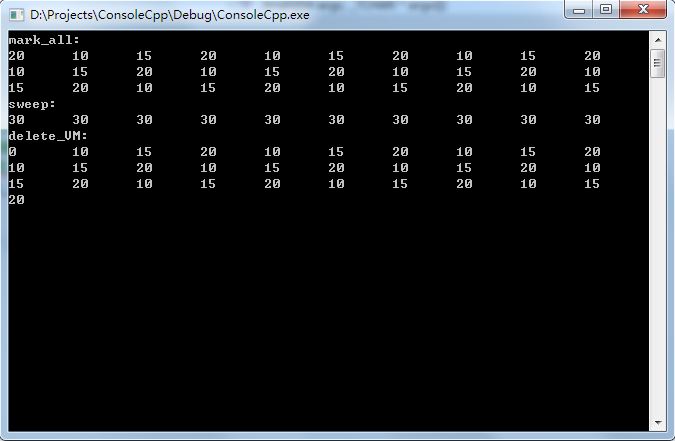Description: Code implementation Learn from this article
There are many ways to find and recycle unwanted objects. The easiest and earliest is called "mark-and-clear". Process:
- Starting with the root object, traverse the entire object graph.Each time an object is accessed, a token bit is set to true.
- Once the traversal is complete, find all unmarked objects and clear them. Suppose we are writing an interpreter for a small language.It is dynamic and has two objects: int and pair.The following is an enumeration that defines the object type:
#include <assert.h> enum Obj_Type { OBJ_INT, OBJ_PAIR };
Implement object type:
struct _Object { Obj_Type type; unsigned char marked;//A marker, if marked, indicates reachability. //union //{ int value;//Stored value struct { _Object* pHead; _Object* pTail; }; //}; _Object *pNext; };
Now we can encapsulate them in the structure of a small virtual machine.The purpose of this virtual machine here is to hold a stack to store the currently used variables.Virtual machines in many languages are either stack-based (such as JVM and CLR) or register-based (such as Lua).Either way, they actually have to have a stack.It stores local variables and intermediate variables that may be used in expressions.
#Define MAX_SIZE 256 //Maximum number of stacks #Define INITIAL_gc_THRESHOLD 128 //Number of objects triggering gc typedef struct _tagVM { _Object* objs[MAX_SIZE]; int max_objs;//Maximum number of objects generated, more than call gc int num_objs;//Record the number of objects now //At the virtual machine level, all objects should be visible. From the user's point of view, some objects may not have any references to them, and the objects will be //Not visible, so //Record all objects generated through the virtual machine with a linked list. _Object *pFirstObj;//Header Pointer of Chain List _Object *pLastObj;//End pointer of chain list int objs_size;//Stack size or stack pointer }VM;
Functions to create virtual machines:
VM* new_VM() { VM *pVm=(VM *)malloc(sizeof(VM)); pVm->objs_size=0; _Object *pObj=create_obj(OBJ_INT); pObj->value=0; pObj->marked=1; pObj->pHead=NULL; pObj->pTail=NULL; pObj->pNext=NULL; pVm->pFirstObj=pObj;//NULL; the first node is not used, pVm->pLastObj=pVm->pFirstObj; pVm->max_objs=INITIAL_GC_THRESHOLD; pVm->num_objs=0; return pVm; }
Release Virtual Machine Function:
void delete_VM(VM *pVM) { _Object *pObj=pVM->pFirstObj; while (pObj!=NULL) { printf("%i\t",pObj->value); _Object *tmp=pObj->pNext; delete_Obj(pObj); pObj=tmp; } free(pVM); pVM=NULL; }
With a virtual machine, we need to manipulate its stack:
void push(VM* pVM,_Object *pObj) { assert(pVM->objs_size<=MAX_SIZE ,"Stack overflow!"); pVM->objs[pVM->objs_size++]=pObj; } _Object * pop(VM*pVM) { assert(pVM->objs_size>0 ,"Stack underflow!"); return pVM->objs[--pVM->objs_size]; }
Functions that generate objects:
_Object * create_obj(Obj_Type type) { _Object *pObj=(_Object *)malloc(sizeof(_Object)); pObj->type=type; pObj->marked=0; pObj->pNext=NULL; return pObj; } _Object * new_obj(VM*pVM,Obj_Type type) { _Object *pObj=create_obj(type); pVM->num_objs++; pVM->pLastObj->pNext=pObj; pVM->pLastObj=pObj; if (pVM->num_objs>pVM->max_objs) { gcVM(pVM); } return pObj; }
With it we can push different types of objects onto the stack:
void push_int(VM* pVM,int value) { _Object *pObj=new_obj(pVM,OBJ_INT); pObj->value=value; push(pVM,pObj); } _Object * push_pair(VM* pVM,int value) { _Object *pObj=new_obj(pVM,OBJ_PAIR); pObj->value=value; pObj->pTail=pop(pVM); pObj->pHead=pop(pVM); push(pVM,pObj); return pObj; }
If we have a parser and interpreter to call these functions, it is a complete language.Here is the tag-clear process: The first phase is the marking phase.
void mark(_Object *pObj,unsigned char marked) { if (pObj->marked) return;//Prevent pair types from referencing each other, causing loops and infinite recursion. printf("%i\t",pObj->value);//Debug Output pObj->marked=marked; if (pObj->type==OBJ_PAIR)//pair type, recursive { mark(pObj->pHead,marked); mark(pObj->pTail,marked); } } void mark_all(VM*pVM) { for (int i=0;i<pVM->objs_size;++i) { //printf("%i\t",pVM->objs[i]->value); if (pVM->objs[i]->type==OBJ_PAIR)//Non Pair node in stack, considered unreachable { mark(pVM->objs[i],1); } } }
The next stage is to iterate through all assigned objects, releasing those that are not marked.
void sweep(VM* pVM) { _Object *pObj=NULL,*pFrontObj=NULL; pObj=pFrontObj=pVM->pFirstObj; while (pObj!=NULL) { if (!pObj->marked) { printf("%d\t",pObj->value);//Debug Output pFrontObj->pNext=pObj->pNext;//Delete the list node, adjust the pointer before and after pointing _Object *tmp=pObj; pFrontObj=pObj=pFrontObj->pNext; free(tmp); pVM->num_objs--;//Current number of objects minus one } else { pFrontObj=pObj; pObj=pObj->pNext; } } }
Finally, there is a garbage collector:
void gcVM(VM*pVM) { mark_all(pVM); sweep(pVM); //After each recycle, we update the value of maxOjbecs based on the number of surviving objects. //This is multiplied by 2 to allow our heap to grow as the number of live objects increases. // Similarly, if a large number of objects are recycled, the heap shrinks pVM->max_objs = pVM->num_objs * 2; }
Then we trigger gc in new_obj based on the number of objects generated. Let's generate some objects to test gc:
int _tmain(int argc, _TCHAR* argv[]) { VM *pVM=new_VM(); for (int i=0;i<10;++i)//Produce some objects { push_int(pVM,10); push_int(pVM,15); push_pair(pVM,20);//Lose the first two object pointers in the stack push_int(pVM,30);//Unreachable } printf("mark_all:\n"); mark_all(pVM); printf("sweep:\n"); sweep(pVM); printf("delete_VM:\n"); delete_VM(pVM); getchar(); return 0; }
The final results are as follows:
